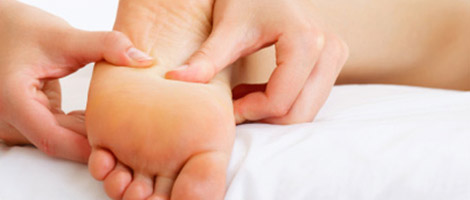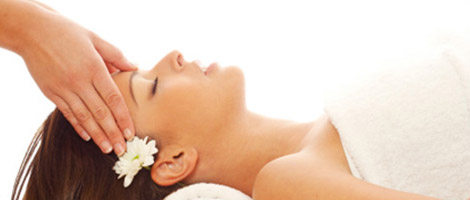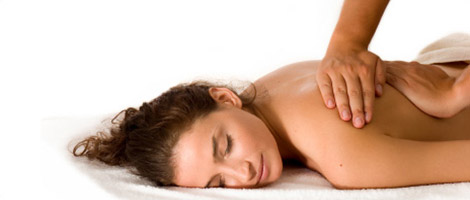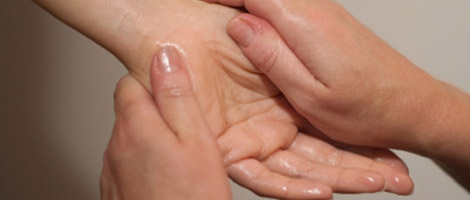
Massage - Foot
Physiologically, feet are the foundation for proper knee alignment, hip and lower back placement. Most doctors prescribe orthotics for your shoes when your back or hips are feeling out of sorts. And since your feet are so important, keeping them happy can lead to a greater sense of well-being in your whole body. And since the tendons, ligaments and muscles are worked so constantly over years and years of serious usage, massaging your ‘dogs’ can actually help keep them strong for more years to come.
On the other hand, foot massages can also be one of the most pleasurable types of body work. More than any other part of your body, your feet connect to a myriad of pleasure centers and are, according to acupuncturists, connected to multiple, seemingly unrelated, aspects of your health.
So break out the foot-cream. Find yourself a generous lover/partner/friend, or even by yourself, and tend to those poor feet. They do so much for you, do something back and show them that you care.
Circulation
Since our feet take such a beating in everyday life, the first thing to do is get the blood flowing to them. Blood brings our muscles all the nutrients that they need, so helping our feet’s circulation is key to their recovery. Thus the first stroke in a good foot massage is called a circulation stroke. The name implies that it increase blood flow in the tissues of the foot.
Grasp the foot with one hand and stroke the top with the other. You can use light pressure along the top of the foot. Moderate pressure might be required on the bottom of the foot to prevent tickling your partner. Continue rubbing and stroking your partners entire foot. Twenty times on the top and ten times on the bottom is suggested.
Rotation of the Foot
Don’t forget about those ankles. They take as much of a beating as your feet and are interconnected. So the next two techniques are going to deal specifically with the ankle and its relationship with the foot. This rotation is not a stretch; it is just a movement to relax the foot and ankle.
Support the foot with one hand as shown. With the other hand, gently move the foot through its natural range of motion. Simply and slowly glide the foot in an oval-type motion. As you slowly rotate the foot, you may find the range of motion increases slightly. Important to note is that there is bone and cartilage in the ankle joint, so only move the ankle as far as it permits, stop if your hear any grinding or crackling. Rotate the foot 3-5 times in each direction.
Stroking the Foot and Ankle
This stroke seems to relax the whole body. Start with your fingertips right where the toes meet he foot. Use both hands to press down between the bones of the foot. Slide your up the foot toward the ankle; when your fingers reach ankle level, wrap your fingers around the ankle and massage the front of the ankle joint with your thumbs.
We generally look for muscle tissue to rub when giving a massage. This area is firm with bone, tendons and ligaments. Try to do your best to treat the muscle tissue you find with thorough kneading.
Flexing and rotating the bones of the foot
This stroke feels really nice when the top of the foot is sore from standing or walking. Press the heel of each hand on the outer edges of the foot. You will be curling the top of the foot. When you curl the foot you will be able to massage the muscle between the bones with your thumbs. While curling the foot you will also that pressing your fingertips into the underside of the foot, will be greeted with oo's and ahh's.
Pulling of the Toes
This can feel good, but be careful. Don’t try and pull the toes too hard. Gently pulling the toes out can free up range and give them a sense of mobility and rejuvenation. Try this in conjunction with a foot bath, since warming the toes can make pulling them more enjoyable and easier. Remember, the point of pulling the toes is not to hear them pop. Simply pulling them will be good enough, but if they pop don't worry - just don’t force them to.
'Soul' Work
The most muscular part of your foot is the bottom, which has pads to protect the bones. When you are working on yourself, this is easiest with your foot propped on the opposite knee, with a towel underneath to protect your clothing from cream. If working on a partner, place their foot either on your knee or prop it on a chair with some pillows under it.
Using your thumbs, make circular motions that cover the entire surface of the bottom of your foot, moving from the base of your toes toward your heel. Keep the pressure of the circles steady and even. Use a bit more firmness on your heels; the skin here is tougher.
Once you have gone over the entire foot give a few extra strokes to any area where you experience chronic pain - the ball of your foot, or the arch, or perhaps around your ankles. One way to relieve cramping in the arch is to hold gentle pressure with one hand, and stretch your foot with the other, but not to the point of pain, just to muscle resistance. Make sure that you don’t hurt yourself or your lover. This part of the foot can be sensitive and digging in too aggressively can hurt, and this is supposed to be relaxing!
Bath ‘em and Polish ‘em
At your local health food store you will inevitably be able to find salts and bath oils specifically designed for bathing one's feet. The heat from the water can loosen muscles and the salts can soothe the skin and their smell can relax the mind. Let them sit until they prune, that way you know that your skin and muscles have been saturated in the warmth. Doing this regularly can increase the vitality of the tendons and integral portions of the foot.
Filing is something that people don't do often enough. This can be done in conjunction with a bath, since the skin is softer and more malleable. Use a large pumice stone to remove the build up of calloused skin, and dirt which can get ingrained in the skin. This is not just an aesthetic exercise. By reducing calluses you can even out your gait and prevent cracking, which is especially important during the summer when we tend to go about barefoot and in sandals more often. Socks help keep our feet moisturized, but callous buildup prevents moisture from getting to our skin.
Take care of your feet, and they will take care of you.


